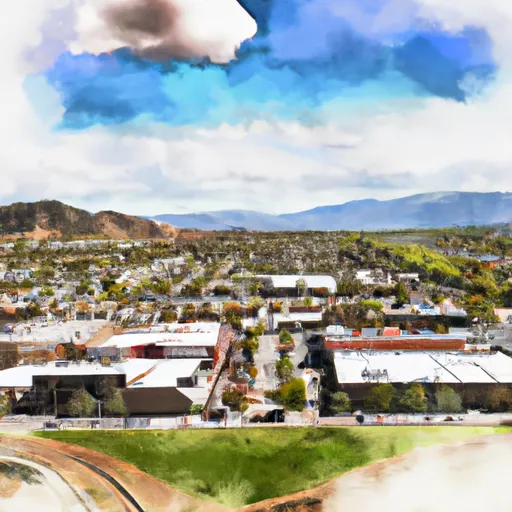-
 Snoflo Premium
Snoflo Premium
Get unlimited access to all our content
With no Ad interruptions! - Start Your Free Trial Login with existing account
Stanton
Eden Index
Climate
8.9
•
Recreation
5.7
•
Community
3.1
•
Safeguard
6.3/10

Stanton, California is a small city located in Orange County. It has a Mediterranean climate, characterized by hot summers with temperatures reaching the 80s and 90s°F and mild winters with temperatures averaging in the 60s°F. The region experiences very little rainfall, with most precipitation occurring from November to March.
Stanton is not situated near any major bodies of water, so its hydrology constituents are limited. However, the city does have a few parks and green spaces that provide outdoor recreational opportunities. Stanton Park is a popular destination with walking paths, picnic areas, and playgrounds for families. Adventure City is another attraction, offering amusement rides, miniature golf, and other fun activities for children.
For those seeking more extensive outdoor activities, Stanton is conveniently located near larger cities like Anaheim and Long Beach, which offer a variety of recreational opportunities. Beaches, such as Huntington Beach and Newport Beach, are within a short drive, providing opportunities for swimming, surfing, and sunbathing. Additionally, several hiking trails and nature preserves are nearby, allowing residents and visitors to explore the natural beauty of Southern California.
What is the Eden Index?
The Snoflo Eden Index serves as a comprehensive rating system for regions, evaluating their desirability through a holistic assessment of climate health, outdoor recreation opportunities, and natural disaster risk, acknowledging the profound impact of these factors on livability and well-being.
Climate Health Indicator (CHI): 8.9
Stanton receives approximately
333mm of rain per year,
with humidity levels near 75%
and air temperatures averaging around
18°C.
Stanton has a plant hardyness factor of
10, meaning
plants and agriculture in this region tend to thrive here all year round.
By considering the ideal temperature range, reliable water supplies, clean air, and stable seasonal rain or snowpacks, the Climate Health Indicator (CHI) underscores the significance of a healthy climate as the foundation for quality living.
A healthy climate is paramount for ensuring a high quality of life and livability in a region, fostering both physical well-being and environmental harmony. This can be characterized by ideal temperatures, reliable access to water supplies, clean air, and consistent seasonal rain or snowpacks.
Weather Forecast
Streamflow Conditions
Santa Ana
Area Rivers
Santa Ana
Snowpack Depths
Santa Ana
Reservoir Storage Capacity
Santa Ana
Groundwater Levels
Recreational Opportunity Index (ROI): 5.7
The Recreational Opportunity Index (ROI) recognizes the value of outdoor recreational options, such as parks, hiking trails, camping sites, and fishing spots, while acknowledging that climate plays a pivotal role in ensuring the comfort and consistency of these experiences.
Access to outdoor recreational opportunities, encompassing activities such as parks, hiking, camping, and fishing, is crucial for overall well-being, and the climate plays a pivotal role in enabling and enhancing these experiences, ensuring that individuals can engage in nature-based activities comfortably and consistently.
Camping Areas
| Campground | Campsites | Reservations | Toilets | Showers | Elevation |
|---|---|---|---|---|---|
| Chino Hills - State Park | 20 | 480 ft | |||
| Sunset Vista RV Park | None | 19 ft | |||
| Millard | 5 | 1,980 ft | |||
| Gould Mesa | 7 | 1,418 ft | |||
| Los Alamitos Army Military | None | 25 ft | |||
| Bohelli Regional Park | None | 1,107 ft | |||
| Glenn Camp | 8 | 2,095 ft | |||
| Bolsa Chica State Beach | 57 | 12 ft | |||
| Seabreeze at Seal Beach Military | None | 15 ft | |||
| Crystal Cove State Park - Moro Campground | 57 | 126 ft |
Catastrophe Safeguard Index (CSI):
The Catastrophe Safeguard Index (CSI) recognizes that natural disaster risk, encompassing floods, fires, hurricanes, and tornadoes, can drastically affect safety and the overall appeal of an area.
The level of natural disaster risk in a region significantly affects safety and the overall livability, with climate change amplifying these risks by potentially increasing the frequency and intensity of events like floods, fires, hurricanes, and tornadoes, thereby posing substantial challenges to community resilience and well-being.
Community Resilience Indicator (CRI): 3.1
The Community Resilience Indicator (CRI) recognizes that education, healthcare, and socioeconomics are crucial to the well-being of a region. The CRI acknowledges the profound impact of these elements on residents' overall quality of life. By evaluating educational resources, healthcare accessibility, and economic inclusivity, the index captures the essential aspects that contribute to a thriving community, fostering resident satisfaction, equity, and social cohesion.

